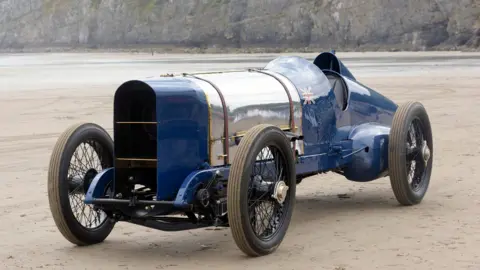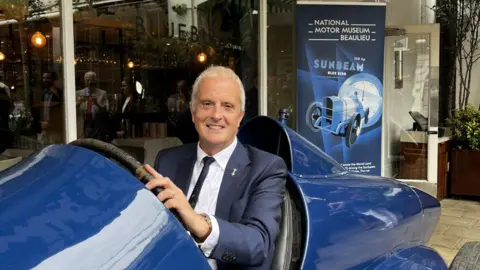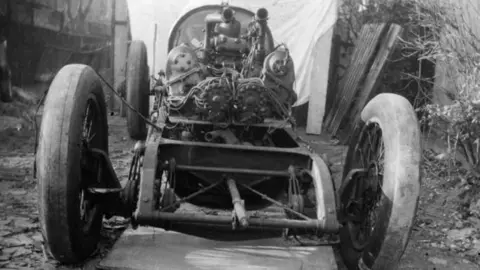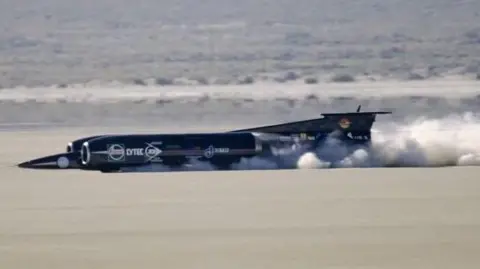World's first 150mph car returns to beach where it broke record
 National Motor Museum, Beaulieu
National Motor Museum, BeaulieuIn 1925, on a beach in south-west Wales, the automotive world was changed forever.
A car dealer named Malcolm Campbell and his 350-horsepower Sunbeam car named Blue Bird, hoped to use the seven miles of Pendine Sands in Carmarthenshire to break the 150mph (241km/h) barrier in a car for the first time.
He had already set - and lost - the world land-speed record several times before, but in front of the world's media, he looked to smash through a target which nobody was sure was possible.
But it was. Over two runs on 21 July 1925, he recorded an average speed of 150.766mph, catapulting him to international stardom.
Now, 100 years later, Blue Bird will be back at Pendine to mark the historic achievement.
 National Motor Museum, Beaulieu
National Motor Museum, BeaulieuIt will be wheeled on to the beach for a ceremonial start-up in front of Sir Malcolm's grandson, Don Wales.
Mr Wales is just one part of Sir Malcolm's record breaking lineage.
Donald Campbell, Sir Malcolm's son, was the only man to hold both the land and water-speed records at the same time, before he was killed at Coniston Water in the Lake District in 1967 in another record attempt.
His daughter Gina broke the women's world water speed record.
While Mr Wales, Donald Campbell's nephew, has previously held UK and world records for the fastest electric car, steam-powered car and quickest lawnmower on Earth.
Mr Wales said: "There's just something in our genes, I think it was Grandad's buccaneering Scottish ancestors.
"We're all family people, but when the red mist of racing descends, nothing matters more than burying our right foot and seeing how fast our vehicles, talent and bravery can take us."
Mr Wales said he thought his grandfather was unprepared for the fame the feat would bring him.
"He went from an aside on the back pages to the main headline in every paper, he had congratulations from the King, and suddenly everyone wanted to be associated with him."
 Visit Wales
Visit WalesPendine was the crucible of land speed records in the 1920s, with enough space for cars to accelerate to - and more importantly brake from - speeds which had become impossible to achieve on racetracks like Brooklands.
Between 1924 and 1927 Sir Malcolm and his friend and rival, Wrexham engineer John Godfrey Parry Thomas tussled for top spot.
Between them they raised the record from 140mph (225km/h) to 176mph (283km/h), before Parry Thomas was killed in his self-build car Babs.
"Grandad and Parry Thomas had very different approaches to the record," Mr Wales said.
"Blue Bird was a sleek track-racing car which had been adapted for land-speed, while Babs was purpose-built for record attempts, with a single-minded focus on the sheer power which was needed to carry it over a mile as quickly as possible.
"The contrast in styles was what kept the public fascinated."
 Campbell Family Heritge Trust
Campbell Family Heritge TrustMr Wales drove Blue Bird on the anniversary 10 years ago, calling it "terrifying and wonderful in equal measure".
But despite its power, Sir Malcolm knew the Blue Bird had "maxed out" and when 200mph was breached at the 23-mile Daytona Beach in Florida by Henry Segrave.
Partly out of respect for Parry Jones - and because of the extra space at Daytona compared with Pendine - Sir Malcolm drove a later iteration of Blue Bird through the 300mph (483km/h) barrier for the first time.
Today, the original Blue Bird is cared for at the National Motor Museum at Beaulieu in Hampshire, though the car has not always had it as good.
 National Motor Museum, Beaulieu
National Motor Museum, BeaulieuIt was rescued from a barn in the 1950s, before spending more than 30 years stationary at Beaulieu before a disastrous attempt to start it again in 1993.
Its chief engineer at Beaulieu Ian Stanfield said: "It never should have happened, you never turn over a car which has been idle for 30-plus years, but the pressure was on to get her running.
"The inevitable happened: the engine seized, she sprung a con rod, and smashed the crank case as well as several valves and pistons."
It took about 10 years to rebuild the engine, with the original Sunbeam factory in Wolverhampton bombed in World War Two, with "next-to-no budget" and begging and borrowing parts where they could.
He worries if the expertise to keep Blue Bird running for another century exists.
"I've been working here for 47 years, and some of my colleagues even longer. We need to find the money and the time to train up the next generation to work on the vehicles which we've been so privileged to care for, and pass on the baton."
 Getty Images
Getty ImagesHowever, Mr Wales is more confident about the future of the land-speed record.
"A hundred years ago nobody knew if 150mph would be possible.
"Today there are two projects looking to exceed 1,000mph.
"If there's the public interest and the desire from the industry to push forward again, there's no reason it couldn't happen in our lifetime.
"The biggest challenge is finding somewhere long enough to attempt it."
